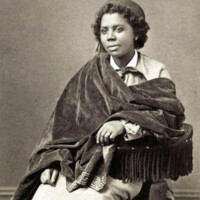Mary Edmonia Lewis
Title
Mary Edmonia Lewis
Description
The first professional African American sculptor, Edmonia Lewis attended Oberlin College from 1859 through 1862. While her time at Oberlin ended in scandal, she went on to have a successful career as an American expatriate artist living in Rome.
Birth Date
On or around July 4, 1844
Birthplace
Henrietta (now Rensselaer), New York
Death Date
September 17, 1907
Occupation
Sculptor
Biographical Text
Mary Edmonia Lewis was a successful artist at a time when there were few female sculptors and even fewer of mixed racial ancestry. Born sometime between 1843 and 1845--she told different stories about her upbringing--her father was of African descent, probably from the West Indies, while her Canadian mother was of mixed African and Chippewa ancestry. Lewis's parents died when she was very young and she and an older brother were raised by maternal aunts. Lewis, who had the native name "Wildfire," later described living a nomadic life with her mother's Chippewa tribe along the shore of Lake Ontario until she was twelve. Her older brother financed her education, first sending her to an abolitionist school in Albany and, in 1859, to the preparatory program at Oberlin College.
At Oberlin, Lewis abandoned her native name of Wildfire and took the name "Mary." In 1860, she entered the Ladies Literary Course at the college and began studying art. One of approximately thirty students of color at Oberlin, she boarded with a dozen white female students in the home of Reverend John Keep, an Oberlin trustee.
In January 1862, Lewis became embroiled in a scandal that reflected deeper racial tensions in the Oberlin community when she was accused of poisoning two of her white friends. Lewis had given both women warm spiced wine before they set out a sleigh ride with their boyfriends, and both became violently ill during the outing. It was later determined that the two young women had ingested a well-known aphrodisiac that can be toxic in large doses. The "poisoning' may have been a prank or accident gone awry. Charges were filed against Lewis, but when she was not arrested, a group of white Oberlin residents took her from her boarding house and beat her badly in an act of vigilante justice.
While Oberlin was founded as a Christian community deeply committed to moral values and racial harmony, it was not immune from racial tensions. Shortly before Lewis's beating, a jewelry store was vandalized when the owner refused to remove a blackface parody clock. Some white Oberlin residents had been urging Black Oberlinians to migrate to Haiti. The poisoning case--and Lewis's beating--embarrassed the town; today, few records about it exist.
Oberlin graduate and pioneering African American lawyer John Mercer Langston defended Lewis and convinced authorities that there was insufficient evidence to indict Lewis. Lewis left Oberlin in 1863 without earning her degree.
From 1863 to 1865, Lewis apprenticed in Boston with sculptor Edward Augustus Brackett. She became known for her busts and medallions of well-known abolitionists; a bust she did of Robert Gould Shaw, the white office who led a black Massachusetts regiment during the Civil War, earned her enough money to visit Europe. In 1865, she settled in Rome where she would remain for much of her life. Lewis once explained that she was "practically driven to Rome in order to obtain the opportunities for art culture, and to find a social atmosphere where I was not constantly reminded of my color. The land of liberty [America] had no room for a colored sculptor."
Lewis created at least sixty full-figure sculptures, thirty of which survive. Her works focused on historical, religious, or mythological themes and many of them reflected her African American and native ancestry. The 1869 "Forever Free" depicted an enslaved couple as they first heard the news of Emancipation. She did a series of sculptures based on the story of the Iroquois leader Hiawatha, who had been immortalized in poetry by Henry Longfellow.
Lewis died in England in 1907. Today her artworks can be found at the Smithsonian's American Art Museum and the Metropolitan Museum of Art. The Allen Art Museum in Oberlin has one of her pieces, an 1874 bust of Black businessman James Peck Thomas.
At Oberlin, Lewis abandoned her native name of Wildfire and took the name "Mary." In 1860, she entered the Ladies Literary Course at the college and began studying art. One of approximately thirty students of color at Oberlin, she boarded with a dozen white female students in the home of Reverend John Keep, an Oberlin trustee.
In January 1862, Lewis became embroiled in a scandal that reflected deeper racial tensions in the Oberlin community when she was accused of poisoning two of her white friends. Lewis had given both women warm spiced wine before they set out a sleigh ride with their boyfriends, and both became violently ill during the outing. It was later determined that the two young women had ingested a well-known aphrodisiac that can be toxic in large doses. The "poisoning' may have been a prank or accident gone awry. Charges were filed against Lewis, but when she was not arrested, a group of white Oberlin residents took her from her boarding house and beat her badly in an act of vigilante justice.
While Oberlin was founded as a Christian community deeply committed to moral values and racial harmony, it was not immune from racial tensions. Shortly before Lewis's beating, a jewelry store was vandalized when the owner refused to remove a blackface parody clock. Some white Oberlin residents had been urging Black Oberlinians to migrate to Haiti. The poisoning case--and Lewis's beating--embarrassed the town; today, few records about it exist.
Oberlin graduate and pioneering African American lawyer John Mercer Langston defended Lewis and convinced authorities that there was insufficient evidence to indict Lewis. Lewis left Oberlin in 1863 without earning her degree.
From 1863 to 1865, Lewis apprenticed in Boston with sculptor Edward Augustus Brackett. She became known for her busts and medallions of well-known abolitionists; a bust she did of Robert Gould Shaw, the white office who led a black Massachusetts regiment during the Civil War, earned her enough money to visit Europe. In 1865, she settled in Rome where she would remain for much of her life. Lewis once explained that she was "practically driven to Rome in order to obtain the opportunities for art culture, and to find a social atmosphere where I was not constantly reminded of my color. The land of liberty [America] had no room for a colored sculptor."
Lewis created at least sixty full-figure sculptures, thirty of which survive. Her works focused on historical, religious, or mythological themes and many of them reflected her African American and native ancestry. The 1869 "Forever Free" depicted an enslaved couple as they first heard the news of Emancipation. She did a series of sculptures based on the story of the Iroquois leader Hiawatha, who had been immortalized in poetry by Henry Longfellow.
Lewis died in England in 1907. Today her artworks can be found at the Smithsonian's American Art Museum and the Metropolitan Museum of Art. The Allen Art Museum in Oberlin has one of her pieces, an 1874 bust of Black businessman James Peck Thomas.
Citation
“Mary Edmonia Lewis,” Oberlin Community History Hub, accessed May 2, 2024, https://megansmitchell.org/DH694/items/show/251.

